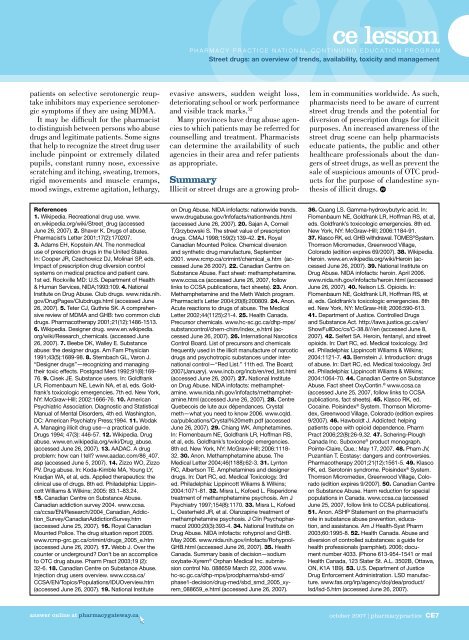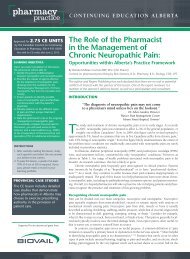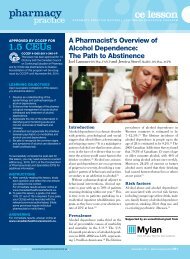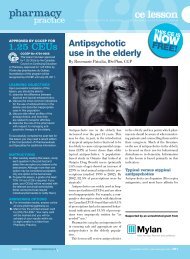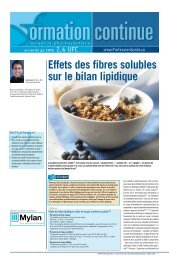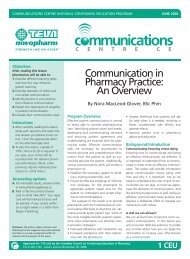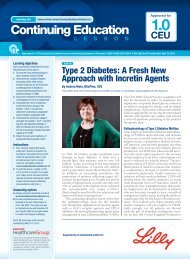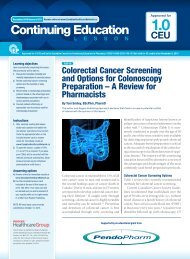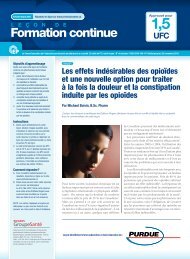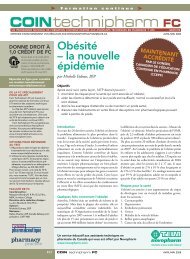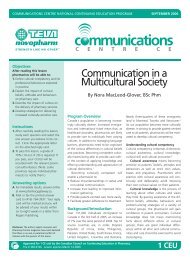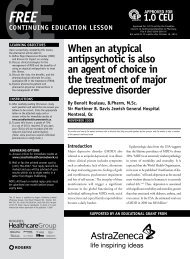cece lesson
cece lesson
cece lesson
You also want an ePaper? Increase the reach of your titles
YUMPU automatically turns print PDFs into web optimized ePapers that Google loves.
patients on selective serotonergic reuptakeinhibitors may experience serotonergicsymptoms if they are using MDMA.It may be difficult for the pharmacistto distinguish between persons who abusedrugs and legitimate patients. Some signsthat help to recognize the street drug userinclude pinpoint or extremely dilatedpupils, constant runny nose, excessivescratching and itching, sweating, tremors,rigid movements and muscle cramps,mood swings, extreme agitation, lethargy,ceStreet drugs: an overview of trends, availability, toxicity and managementce <strong>lesson</strong>Pharmacy Practice national continuing education programevasive answers, sudden weight loss,deteriorating school or work performanceand visible track marks. 52Many provinces have drug abuse agenciesto which patients may be referred forcounselling and treatment. Pharmacistscan determine the availability of suchagencies in their area and refer patientsas appropriate.SummaryIllicit or street drugs are a growing problemin communities worldwide. As such,pharmacists need to be aware of currentstreet drug trends and the potential fordiversion of prescription drugs for illicitpurposes. An increased awareness of thestreet drug scene can help pharmacistseducate patients, the public and otherhealthcare professionals about the dangersof street drugs, as well as prevent thesale of suspicious amounts of OTC productsfor the purpose of clandestine synthesisof illicit drugs. ppReferences1. Wikipedia. Recreational drug use. www.en.wikipedia.org/wiki/Street_drug (accessedJune 26, 2007). 2. Shaver K. Drugs of abuse.Pharmacist’s Letter 2001;17(2):170207.3. Adams EH, Kopstein AN. The nonmedicaluse of prescription drugs in the United States.In: Cooper JR, Czechowicz DJ, Molinari SP, eds.Impact of prescription drug diversion controlsystems on medical practice and patient care.1st ed. Rockville MD: U.S. Department of Health& Human Services, NIDA;1993:109. 4. NationalInstitute on Drug Abuse. Club drugs. www.nida.nih.gov/DrugPages/Clubdrugs.html (accessed June26, 2007). 5. Teter CJ, Guthrie SK. A comprehensivereview of MDMA and GHB: two common clubdrugs. Pharmacotherapy 2001;21(12):1486-1513.6. Wikipedia. Designer drug. www.en.wikipedia.org/wiki/Research_chemicals. (accessed June26, 2007). 7. Beebe DK, Walley E. Substanceabuse: the designer drugs. Am Fam Physician1991;43(5):1689-98. 8. Sternbach GL, Varon J.“Designer drugs”—recognizing and managingtheir toxic effects. Postgrad Med 1992;91(8):169-76. 9. Cisek JE. Substance users. In: GoldfrankLR, Flomenbaum NE, Lewin NA, et al, eds. Goldfrank’stoxicologic emergencies. 7th ed. New York,NY: McGraw-Hill; 2002:1666-76. 10. AmericanPsychiatric Association. Diagnostic and StatisticalManual of Mental Disorders, 4th ed. Washington,DC: American Psychiatry Press;1994. 11. WodakA. Managing illicit drug use—a practical guide.Drugs 1994; 47(3): 446-57. 12. Wikipedia. Drugabuse. www.en.wikipedia.org/wiki/Drug_abuse.(accessed June 26, 2007). 13. AADAC. A drugproblem: how can I tell? www.aadac.com/86_407.asp (accessed June 5, 2007). 14. Zizzo WO, ZizzoPV. Drug abuse. In: Koda-Kimble MA, Young LY,Kradjan WA, et al, eds. Applied therapeutics: theclinical use of drugs. 8th ed. Philadelphia: LippincottWilliams & Wilkins; 2005: 83.1–83.24.15. Canadian Centre on Substance Abuse.Canadian addiction survey 2004. www.ccsa.ca/ccsa/EN/Research/2004_Canadian_Addiction_Survey/CanadianAddictionSurvey.htm(accessed June 25, 2007). 16. Royal CanadianMounted Police. The drug situation report 2005.www.rcmp-grc.gc.ca/crimint/drugs_2005_e.htm(accessed June 26, 2007). 17. Webb J. Over thecounter or underground? Don’t be an accompliceto OTC drug abuse. Pharm Pract 2003;19 (2):32-6. 18. Canadian Centre on Substance Abuse.Injection drug users overview. www.ccsa.ca/CCSA/EN/Topics/Populations/IDUOverview.htm(accessed June 26, 2007). 19. National Instituteon Drug Abuse. NIDA infofacts: nationwide trends.www.drugabuse.gov/Infofacts/nationtrends.html(accessed June 26, 2007). 20. Sajan A, CorneilT,Grzybowski S. The street value of prescriptiondrugs. CMAJ 1998;159(2):139-42. 21. RoyalCanadian Mounted Police. Chemical diversionand synthetic drug manufacture, September2001. www.rcmp.ca/crimint/chemical_e.htm (accessedJune 26 2007). 22. Canadian Centre onSubstance Abuse. Fact sheet: methamphetamine.www.ccsa.ca (accessed June 26, 2007, followlinks to CCSA publications, fact sheets). 23. Anon.Methamphetamine and the Meth Watch program.Pharmacist’s Letter 2004;20(8):200809. 24. Anon.Acute reactions to drugs of abuse. The MedicalLetter 2002;44(1125):21-4. 25. Health Canada.Precursor chemicals. www.hc-sc.gc.ca/dhp-mps/substancontrol/chem-chim/index_e.html (accessedJune 26, 2007). 26. International NarcoticsControl Board. List of precursors and chemicalsfrequently used in the illicit manufacture of narcoticdrugs and psychotropic substances under internationalcontrol—“Red List.” 11th ed. The Board;2007(January). www.incb.org/incb/en/red_list.html(accessed June 26, 2007). 27. National Instituteon Drug Abuse. NIDA infofacts: methamphetamine.www.nida.nih.gov/infofacts/methamphetamine.html(accessed June 26, 2007). 28. CentreQuebecois de lute aux dépendances. Crystalmeth—what you need to know 2006. www.cqld.ca/publications/Crystal%20meth.pdf (accessedJune 26, 2007). 29. Chiang WK. Amphetamines.In: Flomenbaum NE, Goldfrank LR, Hoffman RS,et al, eds. Goldfrank’s toxicologic emergencies.8th ed. New York, NY: McGraw-Hill; 2006:1118-32. 30. Anon. Methamphetamine abuse. TheMedical Letter 2004;46(1188):62-3. 31. LyntonRC, Albertson TE. Amphetamines and designerdrugs. In: Dart RC, ed. Medical Toxicology. 3rded. Philadelphia: Lippincott Wiliams & Wilkins;2004:1071-81. 32. Misra L, Kofoed L. Risperidonetreatment of methamphetamine psychosis. Am JPsychiatry 1997;154(8):1170. 33. Misra L, KofoedL, Oesterheld JR, et al. Olanzapine treatment ofmethamphetamine psychosis. J Clin Psychopharmacol2000;20(3):393-4. 34. National Institute onDrug Abuse. NIDA infofacts: rohypnol and GHB.May 2006. www.nida.nih.gov/infofacts/Rohypnol-GHB.html (accessed June 26, 2007). 35. HealthCanada. Summary basis of decision—sodiumoxybate-Xyrem ® Orphan Medical Inc. submissioncontrol No. 088659 March 22, 2006 www.hc-sc.gc.ca/dhp-mps/prodpharma/sbd-smd/phase1-decision/drug-med/sbd_smd_2005_xyrem_088659_e.html(accessed June 26, 2007).36. Quang LS. Gamma-hydroxybutyric acid. In:Flomenbaum NE, Goldfrank LR, Hoffman RS, et al,eds. Goldfrank’s toxicologic emergencies. 8th ed.New York, NY: McGraw-Hill; 2006:1184-91.37. Klasco RK, ed. GHB withdrawal. TOMES ® System.Thomson Micromedex, Greenwood Village,Colorado (edition expires 69/2007). 38. Wikipedia.Heroin. www.en.wikipedia.org/wiki/Heroin (accessedJune 26, 2007). 39. National Institute onDrug Abuse. NIDA infofacts: heroin. April 2006.www.nida.nih.gov/infofacts/heroin.html (accessedJune 26, 2007). 40. Nelson LS. Opioids. In:Flomenbaum NE, Goldfrank LR, Hoffman RS, etal, eds. Goldfrank’s toxicologic emergencies. 8thed. New York, NY: McGraw-Hill; 2006:590-613.41. Department of Justice. Controlled Drugsand Substance Act. http://laws.justice.gc.ca/en/ShowFullDoc/cs/C-38.8///en (accessed June 8,2007). 42. Seifert SA. Heroin, fentanyl, and streetopioids. In: Dart RC, ed. Medical toxicology. 3rded. Philadelphia: Lippincott Wiliams & Wilkins;2004:1121-7. 43. Bernstein J. Introduction: drugsof abuse. In: Dart RC, ed. Medical toxicology. 3rded. Philadelphia: Lippincott Wiliams & Wilkins;2004:1064-70. 44. Canadian Centre on SubstanceAbuse. Fact sheet OxyContin. ® www.ccsa.ca(accessed June 25, 2007, follow links to CCSApublications, fact sheets). 45. Klasco RK, ed.Cocaine. Poisindex ® System. Thomson Micromedex,Greenwood Village, Colorado (edition expires9/2007). 46. Hawboldt J. Addicted: helpingpatients cope with opioid dependence. PharmPract 2006;22(8):26-9,32. 47. Schering-PloughCanada Inc. Suboxone ® product monograph.Pointe-Claire, Que.: May 17, 2007. 48. Pham JV,Puzantian T. Ecstasy: dangers and controversies.Pharmacotherapy 2001;21(12):1561-5. 49. KlascoRK, ed. Serotonin syndrome. Poisindex ® System.Thomson Micromedex, Greenwood Village, Colorado(edition expires 9/2007). 50. Canadian Centreon Substance Abuse. Harm reduction for specialpopulations in Canada. www.ccsa.ca (accessedJune 25, 2007, follow link to CCSA publications).51. Anon. ASHP Statement on the pharmacist’srole in substance abuse prevention, education,and assistance. Am J Health-Syst Pharm2003;60:1995-8. 52. Health Canada. Abuse anddiversion of controlled substances: a guide forhealth professionals (pamphlet). 2006; documentnumber 4033. (Phone 613-954-1541 or mailHealth Canada, 123 Slater St. A.L. 3502B, Ottawa,ON, K1A 1B9). 53. U.S. Department of JusticeDrug Enforcement Administration. LSD manufacture.www.fas.org/irp/agency/doj/dea/product/lsd/lsd-5.htm (accessed June 26, 2007).answer online at pharmacygateway.caoctober 2007 | pharmacypractice CE7


